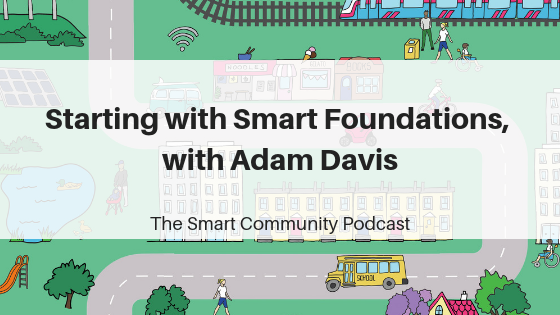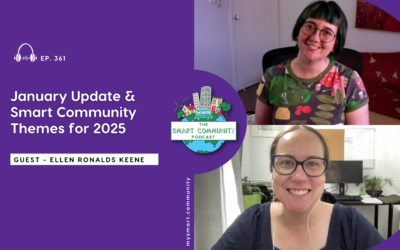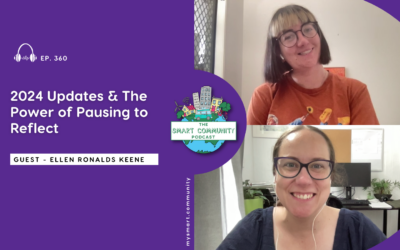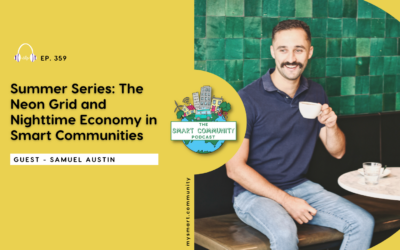In this episode of the Smart Community Podcast, I spoke with Adam Davis, the Director of TPL Connect, and a consultant in the design and delivery of Wired and Wireless Networks in Smart Cities, Data Centres, IoT, Telecommunications and Enterprise sectors. Adam shares with us his background as a cabling technician and project manager, and how working with local councils in ICT design and strategy really sparked his interest in the Smart City space.
Adam tells us how he sees Australia currently embracing the Smart City or Smart Region concept, and some of the mistakes he’s seen Councils make when adopting new technology. We discuss the importance of having an overarching vision or roadmap when undertaking any kind of Smart City planning, and what some of the key components of such a framework are. He shares some of the projects he’s currently working on, primarily focusing on the foundation layer such as fibre infrastructure to support wireless and sensor networks, and the amount of that foundation layer technology that is needed before the 5G network can be usable.
Adam says that boring foundation layer of infrastructure is something that’s often overlooked in the Smart arena, and how it’s an emerging trend/problem we should all be talking about more. We also cover the need for interoperability of new tech so that legacy systems don’t hinder progress, why councils need multidisciplinary teams in order for integration to be successful, and finish our chat discussing the emerging trend of skillset gaps in both city and regional teams, such as lack of data analysts, integration and systems thinking. As always I hope you enjoy listening to this episode as much as I enjoyed making it.
Listen here:
What we cover in this episode:
- Adam’s background as a Cabling Technician and Project Manager, and how he made the shift to start TPL Connect
- How his work with Councils sparked his interest in the Smart Community space
- What Smart means to Adam, and why invisibility is the mark of successful technology
- The importance of overarching framework or vision for Smart City plans, and what some of the key components of that might be
- The opportunities and challenges in Australia’s approach to Smart Regions
- Foundation layer projects that Adam is working on, and why they’re so important
- The hype around 5G and what the reality is actually like right now
- The need for multidisciplinary teams in the regions to facilitate integration and break down silos
- The emerging but overlooked trend of getting the foundation layer of infrastructure right
- Legacy systems, new technology and interoperability
- The emerging skillset gaps in Smart Region teams
Quotes:
”It’s different for every region but at the crux of it, [a Smart Community means] utilizing the data that you can garner from these technologies to make better and more informed decisions, which improves process, improves the lives of the constituents, [business] and the Council alike.”
“A lot of technologies have to be almost invisible…Has technology really succeeded when you don’t even know that you’re interacting with it?”
“What’s the overarching vision for the Smart City or Region? [Once Councils know that they can] work that into a set of defined principles that really reflect that vision…if the technology doesn’t really align to the principles, it won’t align to the vision, so it’s probably not worth implementing.”
“All those technologies have an effect in all streams of business—whether that be the water, the garbage, [the operational side]—the stakeholder management now is huge. And what they are actually deploying then needs to be handed off and be managed by what used to be the IT team. And, now, the IT team is getting more and more IOT Requirements lumped on them as these technologies are deployed. So, having that stakeholder management earlier on in the piece and working across on all streams of business, keeping everyone informed, and thinking about the operational side of the Smart Technology as well is [critical].”
“That’s when you see the successful regions, they’re actively working with local businesses and industry.”
“The boring foundation layer stuff is an overlooked area in the Smart City framework. The changing skillsets that are required within these teams—that’s a key considerable now. The hiring needs to be completely different [than before].”
“Actually looking at what the current requirements are, what the current environment looks like is probably a key thing that people aren’t talking about enough. People are too keen to just get there and be doing something, without having the proper planning.”
Connect:
Find the full show notes as: www.mysmart.community
Connect with Adam via LinkedIn or email adam.davis@tplconnect.com.au
Connect with me via email: hello@mysmart.community
Connect with My Smart Community via LinkedIn or Twitter and watch on YouTube
Podcast Production by Perk Digital






0 Comments